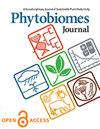The Blueberry Fruit Mycobiome Varies by Tissue Type and Fungicide Treatment
IF 3.3
3区 生物学
Q2 MICROBIOLOGY
引用次数: 0
Abstract
The microbial ecology of agricultural products may provide crucial insights into the management of post-harvest fruit rots. To investigate post-harvest microbial communities of highbush blueberry (Vaccinium corymbosum), five fungicide spray programs were evaluated for their influence on the mycobiome of fruit skin and within the fruit pulp. The mycobiome was characterized by sequencing amplicons of the ITS1 region with primers ITS1f and ITS4 with the Illumina MiSeq 300bp v3 system. Two of the five programs utilized commercial biological fungicides, two utilized azoxystrobin, and one utilized a series of treatments to simulate a realistic disease management program. Fungicide applications reduced diversity of the fruit skin mycobiome (R2=0.409, p=0.0001) and had a moderate impact on the pulp mycobiome (R2=0.233, p=0.0001). The mycobiome of the fruit pulp was also more variable than the skin mycobiome. In comparison to the untreated controls, each fungicide treatment program had a strongly significant effect on the beta-diversity of the blueberry fruit skin mycobiome (R2=0.53-0.73, p=0.0001). In the pulp, three of the five treatments had moderate but significant effects on beta-diversity in comparison to the control (R2=0.10-0.18, p=0.0005-0.017). Most samples indicated that fungi belonging to Epicoccum, Papiliotrema, and Sporobolomyces were widely prevalent and abundant across treatments and tissues. Fruit pathogen Botrytis cinerea was particularly abundant in the pulp of three of fungicide treatments. Results from this study provide a baseline for future exploration of post-harvest rot pathology and provide a community context on how fungicides may alter fungal communities in agricultural systems.蓝莓果实真菌组因组织类型和杀菌剂处理而异
农产品的微生物生态学可能为收获后水果腐烂的管理提供重要的见解。为了研究高丛蓝莓(Vaccinium corymbolsum)采后微生物群落,评估了五种杀菌剂喷雾方案对果皮和果肉内真菌生物群落的影响。用引物ITS1f和ITS4,用Illumina MiSeq 300bp v3系统对ITS1区域的扩增子进行测序,从而对真菌生物群落进行表征。五个项目中有两个使用商业生物杀菌剂,两个使用嘧菌酯,一个使用一系列处理来模拟现实的疾病管理项目。杀菌剂的应用降低了果皮真菌生物群落的多样性(R2=0.409,p=0.0001),并对果肉真菌生物群落产生了中度影响(R2=0.233,p=0.0001)。果肉的真菌生物群落也比皮肤真菌生物群落变化更大。与未处理的对照组相比,每种杀菌剂处理方案对蓝莓果皮真菌生物群落的β多样性都有非常显著的影响(R2=0.53-0.73,p=0.0001),与对照组相比,五种处理中的三种对β多样性有中度但显著的影响(R2=0.10-0.18,p=0.0005-0.017)。大多数样本表明,属于Epicoccus、Papiliotrema和Sporobolomyces的真菌在处理和组织中广泛流行和丰富。果实病原灰葡萄孢在三种杀菌剂处理的果肉中含量特别丰富。这项研究的结果为未来探索收获后腐烂病理学提供了基线,并为杀菌剂如何改变农业系统中的真菌群落提供了群落背景。
本文章由计算机程序翻译,如有差异,请以英文原文为准。
求助全文
约1分钟内获得全文
求助全文

 求助内容:
求助内容: 应助结果提醒方式:
应助结果提醒方式:


